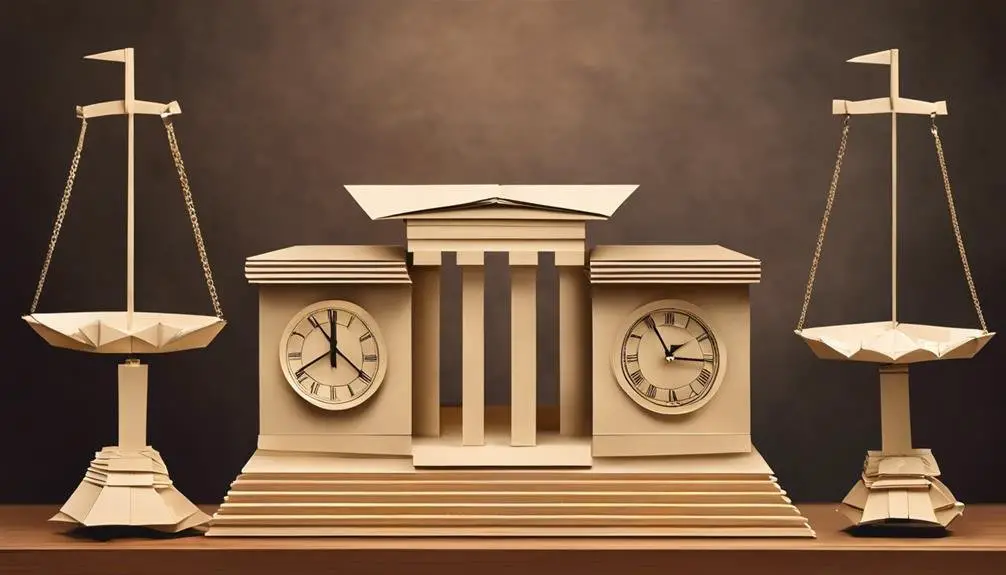The Crime Control Model, with its focus on the swift and efficient administration of justice, ostensibly enhances public safety and deters potential offenders through the promise of quick retribution. However, this approach raises substantive concerns regarding the potential erosion of civil liberties and the fair treatment of the accused.
As we navigate the intricate balance between ensuring public safety and upholding individual rights, it becomes imperative to critically examine the implications of prioritizing one model over the other. The ensuing discussion aims to unpack the nuanced dynamics between the expedited processing of criminal cases and the safeguarding of constitutional protections, inviting a deeper exploration into the complexities of criminal justice policy.
Key Takeaways
- The Crime Control Model prioritizes reducing crime through swift and severe punishment, aiming to deter criminal behavior.
- It can compromise individual rights and due process, leading to potential wrongful convictions and undermining the justice system.
- This approach disproportionately affects people of color and low-income communities, exacerbating social inequality.
- Despite its potential for reducing crime rates, the emphasis on efficiency over accuracy raises concerns about fairness and trust in the legal system.
Historical Background
Emerging in the 1970s as a countermeasure to the escalating crime rates, the Crime Control Model fundamentally reshaped the United States' approach to law enforcement and criminal justice. This model, gaining traction for its focus on swift and severe punishment, sought to deter criminal behavior through the efficient processing of cases, thereby aiming to quickly resolve conflicts and maintain public safety. At its core, the Crime Control Model is built on the premise that controlling crime is of utmost importance, sometimes even at the expense of individual rights.
This prioritization has stirred significant debate, particularly concerning the balance between ensuring public safety and upholding civil liberties. Critics of the model argue that in its quest for aggressive crime control measures, there is a heightened risk of infringing upon due process rights and civil liberties. The model's emphasis on expediency and its potential to sideline the rights of the accused raises questions about the fairness and justice of the criminal justice system, highlighting a critical tension between the desire for security and the commitment to individual freedoms.
Pro: Deterrence Effect

The deterrence effect inherent in the Crime Control Model presents notable advantages in the realm of law enforcement and public safety.
By prioritizing swift and severe punishment, this model aims to reduce crime rates through the fear of legal repercussions.
Consequently, this approach not only enhances public safety but also strengthens the authority and effectiveness of the legal system.
Enhanced Public Safety
One of the crime control model's primary objectives is to bolster public safety by employing deterrence strategies designed to prevent criminal acts. This approach hinges on the belief that increasing the certainty and severity of punishment for criminal behaviors will act as a significant deterrent.
By emphasizing swift and harsh consequences for illegal activities, the model aims to instill a sense of fear among potential offenders, thereby reducing the inclination towards committing crimes. Studies supporting this model have documented a noticeable decrease in criminal activities in areas where such deterrent measures have been rigorously applied.
While this strategy is lauded for its effectiveness in enhancing public safety, it has also sparked a debate regarding the balance between ensuring security and preserving individual freedoms.
Reduced Crime Rates
A cornerstone of the Crime Control Model, the deterrence effect—achieved through the swift and severe punishment of criminal acts—plays a pivotal role in reducing crime rates. This approach is grounded in the belief that the prospect of facing immediate and harsh consequences can effectively dissuade individuals from committing crimes.
Key aspects include:
- The threat of harsh punishment deters potential criminal behavior.
- Increased certainty and severity of punishment contribute to lower crime rates.
- Aggressive law enforcement and quick justice prevent criminal activities.
- Advocates argue it leads to a safer, more orderly society.
- Research supports the deterrence effect in reducing crime rates.
Strengthened Legal Authority
Strengthening legal authority within the Crime Control Model significantly bolsters the deterrence effect, making it a formidable tool against potential criminal behavior. The model's emphasis on increasing both the certainty and severity of punishment creates a potent deterrent. Potential offenders, perceiving the swift and severe consequences of their actions, are more likely to abstain from engaging in criminal activities.
Research supports this approach, indicating that the focus on quick and harsh penalties can effectively reduce criminal behavior. By prioritizing expedited legal processes and strict enforcement, the model enhances its deterrent capacity. The overarching aim is to instill a fear of consequences in individuals, thereby discouraging them from committing crimes.
This approach underscores the Crime Control Model's effectiveness in preventing criminal activities through strengthened legal authority.
Con: Civil Liberties Concerns

The prioritization of swift justice within the Crime Control Model often raises significant concerns regarding the protection of individual civil liberties. In the quest to control crime effectively, this model tends to place a lesser emphasis on ensuring that the rights of individuals are safeguarded, potentially leading to significant civil liberties infringements. The focus on efficiency and rapid processing within the criminal justice system can sometimes overshadow the fundamental principles of fairness and due process.
Key concerns include:
- Potential for Rights Infringements: The drive for efficiency might lead to overlooking or minimizing individual rights.
- Risk of Violating Civil Liberties: The emphasis on controlling crime increases the likelihood of civil liberties being compromised.
- Overshadowing of Due Process: Urgency in crime control can result in due process and fair legal procedures being sidelined.
- Presumption of Innocence at Risk: This foundational legal principle may be weakened in favor of rapid case resolutions.
- Right to a Fair Trial Compromised: The focus on swift justice might lead to hurried trials that do not adequately respect the right to a fair and comprehensive hearing.
These concerns underscore the importance of balancing crime control efforts with the need to protect civil liberties, ensuring justice is both swift and fair.
Pro: Swift Justice

Efficiently addressing criminal activity, the Crime Control Model places a high priority on delivering swift justice. This approach is anchored in the belief that quick apprehension and punishment of offenders not only enhance public safety but also serve as a deterrent to potential criminals. The immediate resolution of cases is pivotal in maintaining social order and instilling a sense of security within the community. By focusing on rapid responses, the Crime Control Model aims to effectively reduce crime rates.
Moreover, the emphasis on swift justice helps streamline the criminal justice process, allowing for the efficient allocation of resources. This expeditious approach minimizes the backlog of cases, ensuring that the legal system remains responsive and capable of addressing new threats to public safety promptly. The ability to quickly bring offenders to justice reinforces the principle that criminal behavior will not be tolerated, thereby contributing to the overall deterrence of crime. In essence, the Crime Control Model's commitment to swift justice is a crucial component in its strategy to combat criminal activity and uphold societal norms.
Con: Risk of Wrongful Convictions

Despite its emphasis on expediency, the Crime Control Model significantly increases the risk of wrongful convictions due to its prioritization of swift punishment over thorough investigation and due process. This approach, while aiming to enhance public safety and reduce crime rates, inadvertently sidelines the fundamental principles of justice and fairness. The core issue stems from a systemic rush to close cases, which can overshadow the essential need to ensure the accuracy of verdicts.
- Innocent individuals may be wrongly convicted, highlighting a grave flaw in the pursuit of quick justice.
- Lack of thorough investigation compromises the integrity of the judicial process, leading to potential errors.
- The rush to solve cases can precipitate premature judgments, often based on incomplete or biased evidence.
- Devastating consequences for the wrongfully convicted and their families underscore the human cost of such errors.
- Efficiency over accuracy creates a perilous imbalance, where the speed of conviction is valued above the certainty of guilt.
This emphasis on expediency at the expense of meticulous due process not only undermines the principles of justice but also erodes public trust in the legal system, highlighting a critical downside of the Crime Control Model.
Pro: Public Safety Enhancement

In bolstering public safety, the Crime Control Model plays a pivotal role by ensuring swift and severe consequences for criminal behavior. This approach prioritizes the rapid apprehension and harsh punishment of offenders, aiming to create an environment where the risk of engaging in criminal activities outweighs the potential benefits. By establishing a high certainty and severity of punishment, it acts as a strong deterrent to those contemplating criminal actions.
The model's emphasis on efficiency in controlling crime contributes significantly to cultivating a sense of security and order within communities. This is achieved through aggressive law enforcement tactics designed to quickly identify and apprehend suspects, thus minimizing the opportunity for further criminal activities. Moreover, the implementation of the Crime Control Model has been associated with notable reductions in crime rates, leading to a safer society. Research indicates that the perceived risk of punishment plays a crucial role in deterring potential criminals, underscoring the effectiveness of this model in enhancing public safety.
Con: Social Inequality Impact

While the Crime Control Model aims to enhance public safety, it inadvertently magnifies social inequality by disproportionately affecting marginalized communities. This approach, while intended to deter crime, can often exacerbate existing disparities within society, leading to a cycle of disadvantage for certain groups. The impact of the Crime Control Model on social inequality can be seen through various lenses, notably in how it targets and affects individuals based on their socioeconomic status and ethnicity.
- People of color and low-income individuals are often targeted and affected by aggressive crime control measures.
- Harsher punishments under this model can lead to an overrepresentation of minorities in the criminal justice system.
- The focus on controlling crime quickly may neglect addressing underlying social issues that contribute to criminal behavior.
- Social inequality can be perpetuated when the Crime Control Model prioritizes punishment over rehabilitation and addressing root causes of crime.
- The disproportionate impact on marginalized communities can lead to a loss of trust in the criminal justice system, further alienating these groups.
Conclusion
In conclusion, the Crime Control Model presents a complex array of benefits and drawbacks, balancing the need for swift justice and public safety against the risks of infringing on civil liberties and exacerbating social inequalities.
While it offers the potential for deterrence and rapid resolution of criminal cases, the model also carries significant concerns regarding wrongful convictions and the impact on marginalized communities.
The ongoing challenge lies in finding an equilibrium that ensures both effective crime control and the protection of individual rights within the justice system.










